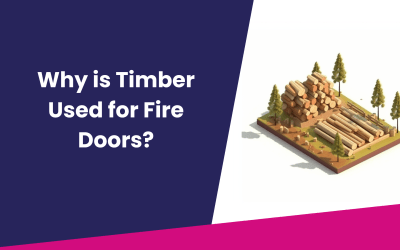We talk a lot about the importance of fire doors in saving lives and minimising damage to property.
But fire doors can only be effective if they are inspected regularly to check for damage or imperfections that could impact the integrity of the door.
In this blog post, we explore what a fire door inspection involves, how often inspections should take place and the legal implications of non-compliance.
What Happens During an Inspection?
Before you begin, you’ll need to check whether an intrusive or non-intrusive inspection is required.
An intrusive inspection involves removing the architraves, checking the linear gap seal and, in some cases, dismantling ironmongery to check for correct intumescent protection. Intrusive inspections can be a good option for newly installed doors if the architraves haven’t yet been fitted.
A non-intrusive inspection is where you only check what you can see without taking anything apart. It’s much quicker and doesn’t create any damage so it’s what most people will opt for. However, the results of the survey can be limited.
Once you’ve established which doors need to be inspected and what type of inspection is required, you’ll need to try and obtain a certificate data sheet, technical manual for the door and hardware, and/or site plans and drawings.
If the certificate data sheet isn’t available (known as a nominal door), you’ll need to make a note of it in your report and use your professional judgement to carry out the inspection.
During the fire door inspection, the following components must be thoroughly inspected and documented:
The Door Frame
A fire door frame must be installed in accordance with the door leaf manufacturer’s installation instructions. These will detail the frame material, jointing type, sectional size and fixing methods allowed for the frame. You’ll need to check how the frame has been jointed, what material it’s made from, and the position of the frame and wall fixings. It’s important to also check the frame for any defects, like gaps, cracks or damage, that could allow fire to escape.
The Door Leaf
The door leaf is the most important component of any fire door set. During an inspection, you should check whether the door leaf is damaged, if it’s bowed or twisted, if it’s been over-morticed at fixing points or trimmed beyond its allowed tolerance. Depending on the extent of the damage, the door leaf may need to be replaced.
Door Leaf Gaps
Most fire door certificate data sheets say not to exceed 4 mm at the top edge and vertical edges and 3.5 mm at the meeting edge of double-leaf doors. BS 8214 specifically states that a suitable operating gap to avoid burn through is 2 – 4 mm. The threshold gap (the gap at the bottom of the door to the floor) is typically 8 mm – 10 mm, however in the case of doors that need to stop fire and smoke e.g. FD30s or FD60s the the required threshold gap is 3 mm. There are many tools people use to measure the gap but a reliable option is a taper gauge.
Hinges
It’s crucial to inspect hinges as they must be able to cope with the weight of the fire door. They should also be fire rated, with a melting point above 800°C. In your inspection, you should check how many hinges are in place, whether there is any excessive black oil, the knuckle diameter and blade size, and the gauge and length of the fixing screws. Some door leaves require intumescent protection behind the hinge blades so check the certificate data sheet if possible.
Glazing
The primary purpose of glazing on a fire door is to provide vision through the door leaf. It’s important to check whether the glazing is fire rated, whether there is any damage or signs of retrofit, and check the type of glazing beading and any gasket visible between the glass and the beads.
Self-Closing Device
Self-closing devices are found on most fire doors in non-domestic buildings. They should have evidence showing they can perform in a fire and be compatible with the door leaf certification. Once you’ve documented the type of self-closing device and the configuration it’s installed in, check if there’s any damage, whether it closes fully against the rebate stop and whether it’s in the correct position.
Lock or Latch
Not all fire doors will have a lock or latch installed. If a fire door is unlatched, you should check to see if it’s suitable to be used that way. When carrying out your inspection, record the type of lock or latch fitted, any markings it has, and its dimensions and position. After this, check whether it’s fitted and working correctly, and whether there’s any visible damage.

How Often Should an Inspection Take Place?
The BS:9999: Code of Practice for Fire Safety in the Design, Management and Use of Buildings, provides a best practice framework for fire safety. It gives recommendations and guidance on the ongoing management of fire safety in a building throughout the entire life cycle of the building.
Over time, everyday use of fire doors can cause slight damage or alterations to the door leaf, the door frame and other crucial components. This can impact the door’s performance, potentially rendering it useless in the event of a fire.
As such, fire doors require regular inspection to check for any wear or tear that could cause the fire door to fail later down the line. But what do we mean by regular inspections?
According to the standard, fire doors should be inspected at least every six months. This is to make sure they’re fit for purpose and will do the job they’re supposed to do in the event of a fire.
There are some exceptions to the rule, however. Regulation 10 is a relatively new regulation that came into force in January 2023. It followed the devastating Grenfell Tower fire and is specific to residential buildings over 11 metres in height in England.

The regulation makes it a legal requirement for ‘responsible persons’ for these buildings to undertake quarterly checks of all fire doors in the common parts. And undertake (on a best endeavour basis) annual checks of all flat entrance doors that lead onto a building’s common parts.
The Fire Safety Order 2005 (FSO) provides a framework for regulating fire safety in all non-domestic premises in England and Wales. Article 17 of the reform makes it a legal requirement to ensure that fire resisting doors and escape doors are correctly installed and adequately maintained.
Because it’s a risk-based document, it states that the frequency of inspections should be determined by the risk to the safety of people and the expected usage of the doors.
In other words, how often you inspect your fire doors depends on how often they’re used. If it’s a high footfall premises, like a school, hospital or commercial building, you will need to have the fire doors inspected more regularly.
This decision should ultimately be determined by the designated ‘responsible person’ after a thorough risk assessment.
What Are the Legal Implications?
Regulations are there for a reason. Fire doors play an integral role in a building’s fire protection system, so it’s critical that they’re checked regularly to ensure they are in working order.
By ignoring the regulations, you’re putting lives at risk. Failing to comply could also lead to hefty fines and prison sentences, impacting your reputation, profits, and the livelihoods of those who work for you.
It’s vital therefore that the laws and regulations are understood and respected.
Who Should Carry Out the Fire Door Inspection?
Fire door inspections should only be carried out by a qualified fire door inspector (competent person). They must be completed by a certified fire safety technician, who is able to stringently assess each of the key components for damage, faults or alterations.
At UK Fire Door Training, we’ve developed a course to improve your skills, knowledge and competency when inspecting fire doors. Ideal for anyone looking to become a professional fire door instructor, the course will enable you to:
- Recognise the importance and role of fire doors
- Describe what fire doors are made from and explain how they work
- Identify the laws, regulations and standards that affect fire doors
- Recall how to find and use certificate data sheets and apply this knowledge in practice
- Explain what fire door ratings and configurations are
- Plan a fire door inspection job
- Inspect a fire door (including post-inspection handover)

Who Should Carry Out the Fire Door Inspection?
Well, Regulation 10 Inspections can be carried out by the responsible person. However, any thorough fire door inspections should only be carried out by a full trained and qualified fire door inspector (competent person). They must be completed by a certified fire safety technician, who is able to stringently assess each of the key components for damage, faults or alterations.
At UK Fire Door Training, our Fire Door Inspection Course is designed to improve your skills, knowledge and competency when inspecting fire doors. Ideal for anyone looking to become a professional fire door instructor, the course will enable you to:
- Recognise the importance and role of fire doors
- Describe what fire doors are made from and explain how they work
- Identify the laws, regulations and standards that affect fire doors
- Recall how to find and use certificate data sheets and apply this knowledge in practice
- Explain what fire door ratings and configurations are
- Plan a fire door inspection job
- Inspect a fire door (including post-inspection handover)




0 Comments